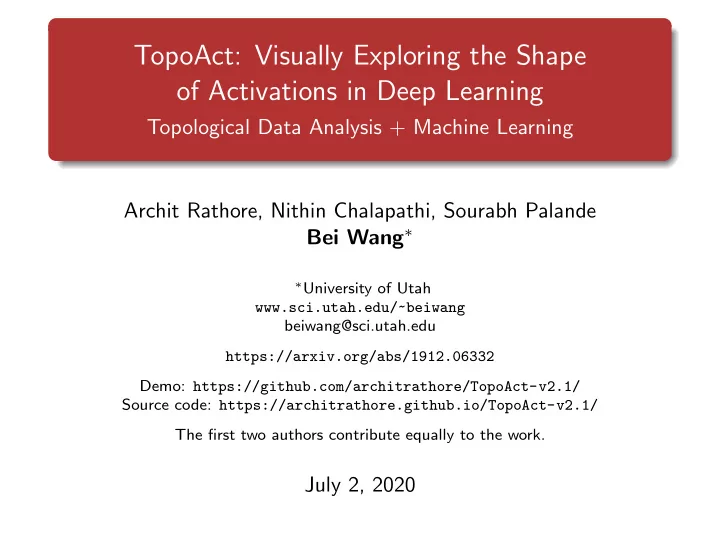

TopoAct: Visually Exploring the Shape of Activations in Deep Learning Topological Data Analysis + Machine Learning Archit Rathore, Nithin Chalapathi, Sourabh Palande Bei Wang ∗ ∗ University of Utah www.sci.utah.edu/~beiwang beiwang@sci.utah.edu https://arxiv.org/abs/1912.06332 Demo: https://github.com/architrathore/TopoAct-v2.1/ Source code: https://architrathore.github.io/TopoAct-v2.1/ The first two authors contribute equally to the work. July 2, 2020
Acknowledgment This project started with a twitter message by Chris Olah shared by Je ff Phillips. NSF DBI-1661375, NSF IIS-1513616, NSF IIS-1910733
Let us start with Twitter...
Let us start with Twitter... TDA + NN Representations?
Interpretability: a main challenge in deep learning What representations have these neural networks learned that could be made human interpretable? Given a trained NN, we probe neuron activations (combinations of neuron firings) in response to a particular input image. With millions of input images, we would like to obtain a global view of what the neurons have learned by studying neuron activations at a particular layer, and across multiple layers of the network.
Topology of neuron activations What is the shape of the space of activations? What is the organizational principle behind neuron activations? How are the activations related within a layer and across layers? Ingredients: Neuron activation vectors as point clouds Mapper graphs as summary graphs Feature visualization Interactive and exploratory visual analytics
Take home message for TopoAct Capture topological structures (branching and loop structures) in the space of activations that are hard to detect via DR O ff er new perspectives on how a NN “sees” the input images. A B C
GoogLeNet (InceptionV1) Trained on ImageNet ILSVRC. Image: https://distill.pub/2019/activation-atlas/
What is neuron activation? Fix a pre-trained model, a particular layer of interest, an input image: We feed an input image to the network and collect the activations (the numerical values of how much each neuron has fired with respect to the input). The activation of a neuron is a non-linear transformation (i.e., a function) of its input. A single neuron produces a collection of activations from a number of overlapping patches of an input image. We randomly sample a single activation from these patches. Image: https://distill.pub/2018/building-blocks/
What is neuron activation? Fix a pre-trained model, a particular layer of interest, an input image: Image: https://distill.pub/2018/building-blocks/
TDA of activation vectors for InceptionV1 Suppose an input image has 14 × 14 patches. A neuron within layer 4c outputs 14 × 14 activations per image. Randomly sample a single activation from the 14 × 14 patches. Each activation vector is high-dimensional; its dimension depends on the number of neurons in that layer. Layers 3a, 3b, and 4a have 256, 480, and 512 neurons respectively, producing point clouds in 256, 480, and 512 dimensions. 300 , 000 images → 300 , 000 activation vectors for a given layer. We then apply the mapper framework to obtain topological summary graphs of these point clouds.
Here comes the math...
Recommend
More recommend